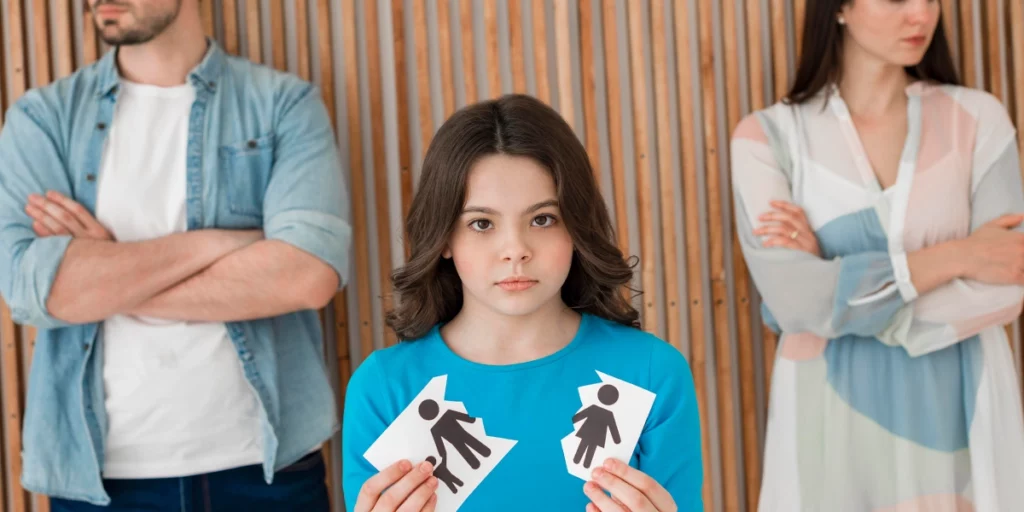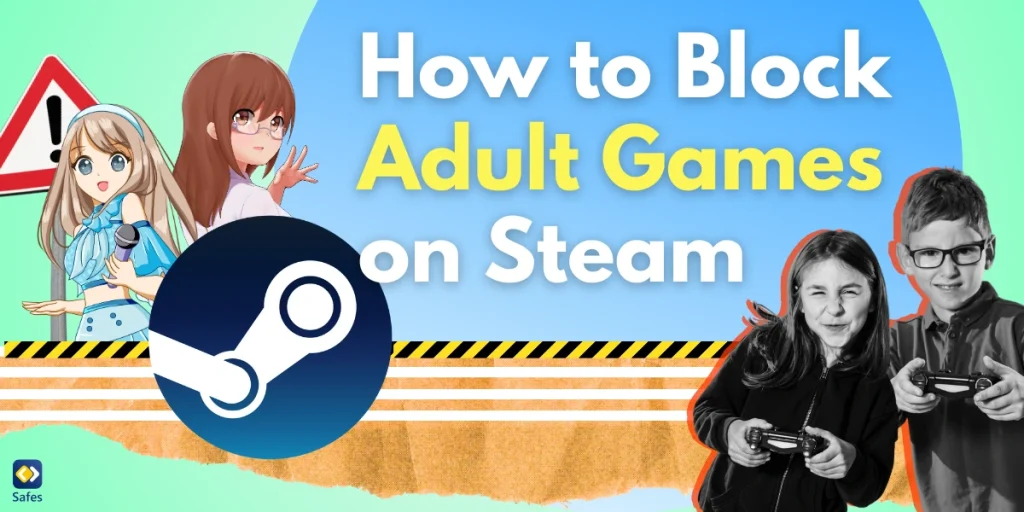“Hi, my name’s Leonard, I’m 42 and I have a 5-year-old daughter. Before talking about my problem, I’d like to take the time to thank you guys. Your content has helped me a lot through my parenthood journey, but I’ve never reached out to you. Now I have a problem that I think you can help me with. Here it goes: My wife and I have been married for 12 years. After years of conflict and arguments, we’ve finally come to the conclusion that it’s best for us to get divorced. But as you know, divorce with young kids can be challenging. How can we make the process easier and less harmful for our daughter? Thank you in advance.”
Download and Start Your Free Trial of the Safes Parental Control App
Dear Leonard, we appreciate your kind words. Here we’ll explain how to divorce with kids without making things hard for them.
Divorce Prevalence and Its Impact on Children
Divorce is becoming increasingly common in the United States, with around 50% of marriages ending in divorce. Divorce can have a profound impact on children, as it can leave them feeling confused, lonely, and insecure. It can also lead to behavioral issues, such as depression or anxiety, as well as academic struggles. Additionally, children of divorce may struggle with forming and maintaining relationships with their peers. Ultimately, the impact of divorce on children can vary greatly depending on the age of the child, the quality of the parent-child relationship, and the support available. Therefore, it’s very important that you are prepared to control the situation with prior knowledge and pay extra attention to your children’s needs.
Put Your Children First
Divorce can be a multifaceted process. It’s a big change for both people who have decided to stop living with each other. Aside from the emotional toll that it takes on them, there will be a lot of legal and financial issues that they will have to take care of. However, when you have children, all those issues will lose their priority. Parents will have to try to make decisions that are in their children’s best interest. Effective collaboration between parents is the first step to take when getting divorced with kids.
Co-Parenting Effectively
The benefits of effective co-parenting are numerous. When both parties are involved in raising a child, it increases stability and consistency in a child’s life. This co-parenting relationship can provide a child with the benefit of two loving, supportive, and involved parents. Additionally, effective co-parenting can help to minimize conflict between the two parents and foster open and honest communication. This can also lead to greater financial stability as two parents can help to make more informed decisions regarding the family’s expenses.
However, like everything else, co-parenting is not without challenges. These challenges include disagreements between the parents, difficulty communicating, and the potential for negative emotions to arise when the two parents are in contact. Additionally, it can be difficult to balance the responsibilities of each parent, as well as to manage expectations between the two.
Here are some ways that will help you co-parent more effectively:
Communicating With a Co-parent
It’s important to communicate in a respectful and cooperative way with your co-parent. Even if you disagree, you should be respectful and listen to each other’s perspectives. This can be done by not making personal attacks and by staying focused on the issue at hand. Additionally, it’s essential to take time to talk and really understand each other’s point of view. This can be done through active listening and expressing empathy for each other’s situation.
Remember, both of you should focus on the best interests of your daughter when making decisions. Parents should work together to create agreed-upon parenting plans that will support their children and their needs. Additionally, try to be flexible and take into account changes in the children’s lives that may require changes to the parenting plan. It’s also important to be open to compromise and negotiation when making decisions. Overall, by communicating effectively and focusing on the best interests of the children, parents can create a cooperative co-parenting relationship.
For additional information, I recommend reading these 3 blog posts on co-parenting:
- Creating a Stress-Free Co-Parenting Schedule + Template
- Co-Parenting: Creating Effective Communication Guidelines
- Tips for Co-Parents on Using Technology to Enhance Children’s Lives
Minimizing conflicts
Two people who are going through divorce have disagreements; that’s normal. But remember that co-parenting is not a way to win the fight with your ex, but a collaboration to do what’s best for your child. The most important thing for co-parents to keep in mind is that both parents should be consistent and on the same page with parenting decisions. They should communicate openly and regularly to ensure that their expectations and rules are in sync. Co-parents should also set realistic expectations and boundaries for their children and be clear about the consequences of misbehavior.
To reduce potential conflicts between co-parents, they should establish a system of respect, understanding, and compromise. It’s important that both parents are willing to consider the other’s point of view and be open to negotiation. Co-parents should also work to maintain an amicable relationship for the sake of the children and keep their disagreements aside.
Create a Supportive and Consistent Environment
Going through a divorce with young kids can be unsettling. Therefore, creating a supportive environment and offering consistency to them is important. Try to establish a consistent schedule for your children that includes both structured activities and free time. This will provide them with a sense of stability and help them adjust to the changes in their lives.
You should also maintain consistent discipline and boundaries for your children, so they know what’s expected of them. Having a daily ritual such as family dinner or bedtime stories will provide them with a sense of comfort and security.

Managing Emotional and Behavioral Responses
Young children may express their emotions in a variety of ways depending on their age and individual personalities. Common emotional responses they may display during divorce include sadness, anger, anxiety, and depression. These emotions can manifest in confusion and guilt, as well as fear of the unknown and a sense of abandonment.
Behaviorally, children may exhibit a range of responses during a divorce. They may become withdrawn and struggle to concentrate or have difficulty sleeping. They may act out aggressively, become clingy, or even regress to earlier developmental stages. Refusal to cooperate is also a common behavioral response to divorce among young children.
Supporting Children
It’s important to create an open and supportive environment for your child when going through a divorce. Acknowledge their emotions and be patient with them as they process their feelings. Encourage your child to talk about their feelings and provide comfort and reassurance.
Show your child that you are still there for them and available to listen. Spend quality time together doing activities that they enjoy and create a routine that will help them maintain structure. Make sure to also practice self-care, as this will help you to be better equipped to support your child during this time.
There’s a plethora of resources that can help children with trauma. Today’s technology has made these resources accessible to the majority of people. You can find lots of useful websites and child-appropriate content to share with your kid. However, the internet is a double-edged sword, and you should be careful about the negative effects of the internet on child development. To handle this problem, we recommend using the Safes parental control app, as it’s easy to use and can be installed on all platforms, such as iOS, Android, and Windows. You can also try it for free to see how it helps in managing your child’s online activities.
Further, if you see that your daughter is having a hard time dealing with the divorce, seek help from professionals. They will teach her about positive coping strategies and help her through this hard time.
Creating a Parenting Plan
A parenting plan is a document that is created when two parents are going through a divorce and are in the process of determining how to share custody of their children. The purpose of a parenting plan is to ensure that the children’s needs are met and to provide both parents with a clear, structured plan for how parenting time and responsibilities will be shared. A parenting plan typically includes the following components:
- A schedule for when each parent has custody of the children
- A plan for holidays, vacations, and special occasions
- A plan for communication between the parents
- A plan for decision-making regarding the children (e.g., who makes decisions about school, health care, etc.)
- A plan for the exchange of information about the children (e.g., school reports, medical records, etc.)
- A plan for how to handle changes in the plan
- A plan for how to handle conflicts between the parents
There is no specific parenting plan that will apply to all families. Parents should set the plan according to the family’s needs and circumstances. Also, as children age, their needs change as well. Therefore, it’s important to modify the plan when the time comes.
Legal and Financial Issues
Common legal issues that may arise during a divorce with young children include child custody, child support, visitation rights, and division of assets. Depending on the location, there may be a multitude of laws in place to ensure that the children’s best interests are taken into account when it comes to the legal matters of the divorce.
When it comes to financial issues that may come up during a divorce with young children, there are several considerations. Both parents need to come to an agreement on how to divide shared assets and debts. This may include items such as bank accounts, cars, and houses. Additionally, the court may order one parent to pay child support to the other in order to help pay for the children’s living expenses. Both parents are also responsible for providing health insurance for the children until they reach the age of majority. Finally, the court may order one parent to pay alimony to the other if they are at a financial disadvantage due to the divorce.
Managing Legal and Financial Issues
The best way to manage legal and financial issues during a divorce with young children is to prioritize their needs. It’s important to focus on the well-being of your daughter and keep her out of conflict. When making decisions, consider your daughter’s best interests and safety.
When it comes to the division of assets and debts, make sure that the division is fair and equitable. In some cases, it may be necessary to involve a third-party mediator, such as a professional, to come to an agreement. Additionally, it’s important to make sure that any child support payments are made in a timely manner, so your child’s needs are met. Finally, you should make sure that all legal documents related to the divorce are properly filed with the court so as to protect the rights of both parents.
Conclusion
Divorce with young kids can be a difficult process, but it’s important to always put your child’s needs first. This needs compromise and putting aside any disagreements, whether it’s in setting co-parenting rules, dealing with your daughter’s emotional needs, coming up with a compatible parenting plan, or managing legal and financial issues. Every family’s situation is unique, so it’s important to take an individualized approach when making decisions related to the divorce.
We hope that we’ve provided you with useful information and we wish you and your daughter the best!
Your Child’s Online Safety Starts Here
Every parent today needs a solution to manage screen time and keep their child safe online.
Without the right tools, digital risks and excessive screen time can impact children's well-being. Safes helps parents set healthy boundaries, monitor activity, and protect kids from online dangers—all with an easy-to-use app.
Take control of your child’s digital world. Learn more about Safes or download the app to start your free trial today!



